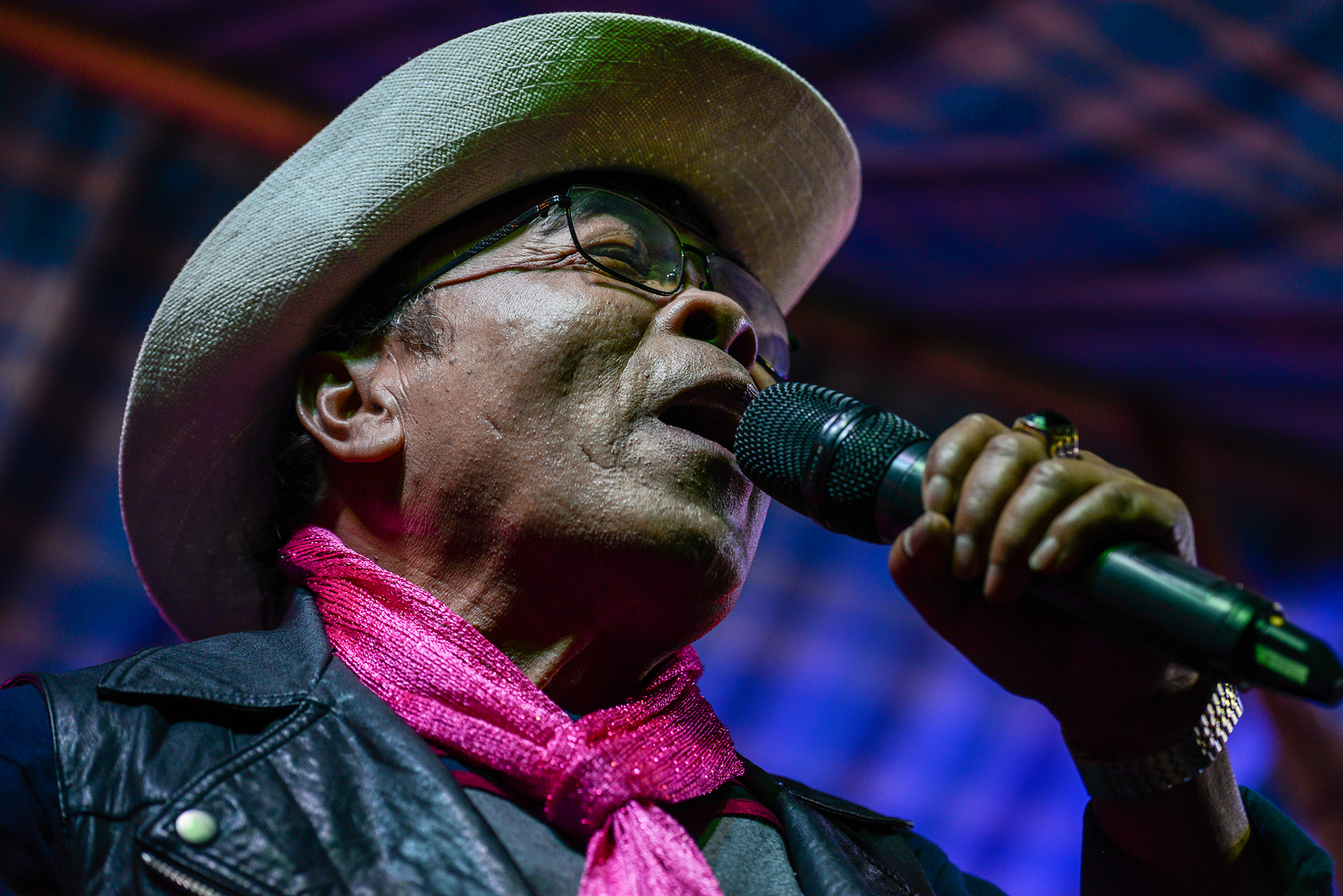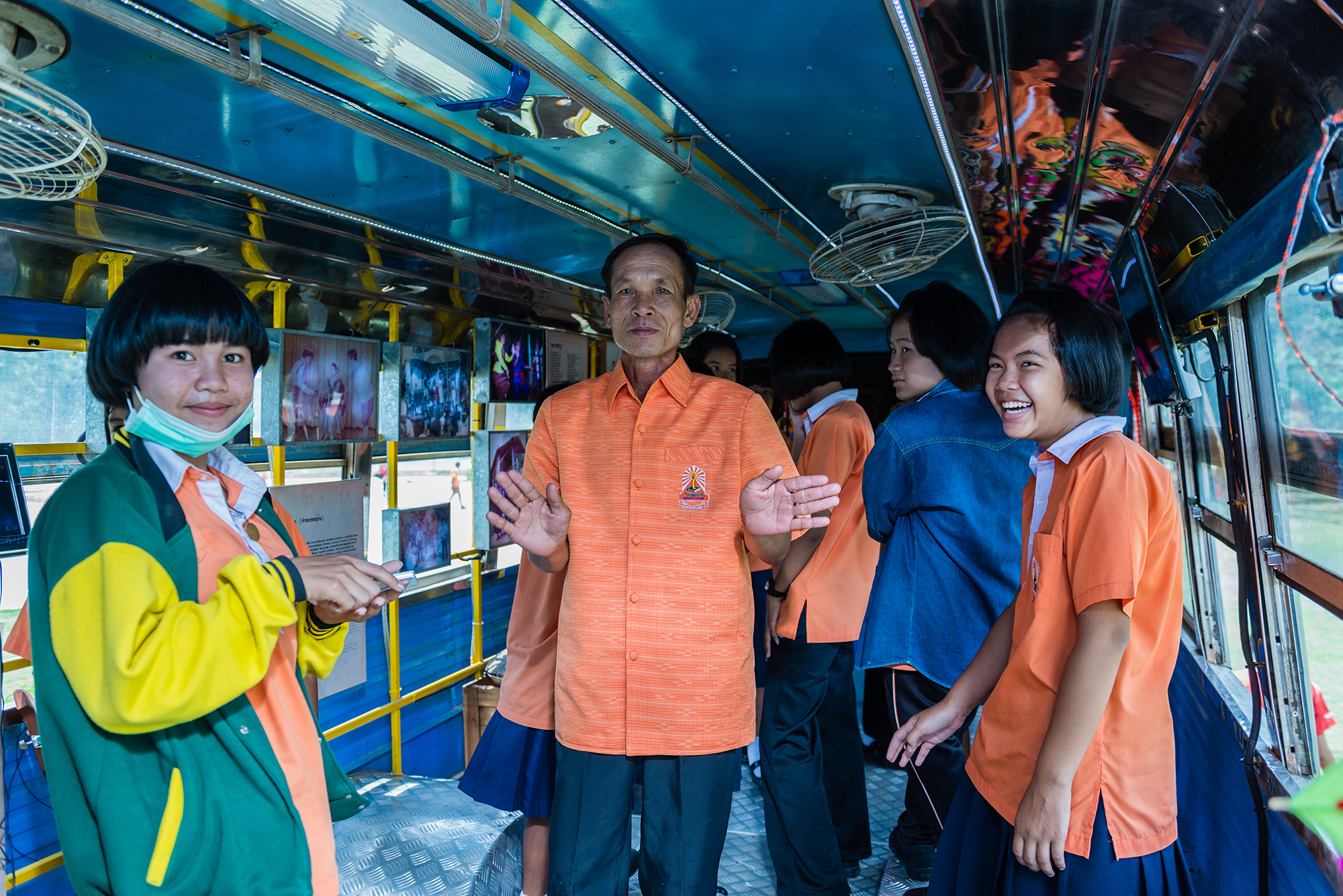Gentlemen’s Guide: Bangkok’s 5 Best Barber Shops
These top 5 barber shops in Bangkok are where gentlemen can elevate ...

[This story originally appeared in Koktail Magazine issue 2.]
[All photos courtesy of John Clewley.]
I was a bus conductor in Salford, Manchester many years ago, travelling the bus routes in Lancashire’s northwest on a double-decker bus with my trusty driver, Mike Arshad. In the football season, we would also ferry Manchester United fans to Old Trafford. Many years later, I’m on another bus, only this time it’s both an exhibition and a stage on wheels. The Mobile Morlam Bus, a project developed by the Jim Thompson Farm and the Jim Thompson Art Center (JTAC), made its debut in 2015 at the uber-hip Wonderfruit, a four-day arts and lifestyle festival held annually in a field just outside Pattaya.
Morlam is the traditional and popular music of ethnic Laotians in Thailand’s Isan, or northeast region, with roots that stretch back centuries. It’s a narrative folk art with origins in animism, Buddhism and repartee-style courting music. JTAC artistic director Dr Gridthiya Gaweewong explained its background, “The project on Isan music and culture began in 2012 with a Morlam band competition for high school and university students. It was an extension of the ‘Isan Village’ at Jim Thompson Farm we built at Pak Thong Chai in Korat Province.”

Morlam stars Arthid Khamhongsa and Weerayut Seekhunlio play the phin and sor on stage
Pak Thong Chai is where the legendary silk pioneer, Jim Thompson, sourced raw silk from local weavers for his Thai Silk Company. He set up his textile factories in the same district. Korat is also known as the “Gateway to Isan”.
The Morlam competition was a resounding success so the board of directors at the Thai Silk Company decided to continue researching the historical roots of the genre. “Once we had enough material and research, we held an exhibition at JTAC called ‘Joyful Khaen, Joyful Dance’,’’ said Gaweewong.
The exhibition attracted many Bangkokians, but Gaweewong and her team felt that it hadn’t reached enough people. “We decided to take the show on the road,” she told Songlines magazine. “We wanted to reach out to farmers, taxi drivers, factory workers and school kids. It’s their music, but we also wanted to reach out to those who didn’t know the music as well, like those at Wonderfruit.”

Isan villagers enjoy the interactive installations aboard the bus
Morlam Bus curator Arthit Mulsarn said the idea came from how Morlam bands travel the concert circuit in Isan on a bus piled up with musicians, costumes and instruments. He found an old Thai Silk Company employee bus and renovated it. JTAC commissioned well-known Japanese designer Jiro Endo and creative technologist Woraya Boonyapanachoti to design a miniaturised version of the exhibition. They added a flatbed truck that doubled as a stage complete with lights, a sound system, a typical country-style jungle backdrop and a gigantic balloon with a design based on an Isan pakaoma (traditional plaid cloth). From the outside, the bus, festooned with pennants and bare light bulbs, looked like part of a Thai temple fair.
Inside, the bus was decked out with photos, vinyl discs with album covers, cassettes and a small shrine for paying homage to teachers in a wai khru ceremony. Musical instruments like the phin (Isan lute) and khaen (free-reed bamboo mouth organ) along with keyboards and a saxophone were available for visitors to try out. A listening post and a video post showed documentary films on the history of Morlam.

Security guards sneak in for a viewing of the exhibit at Maiiam Art Gallery
One feature of the bus that really caught the imagination of people when it debuted at Wonderfruit 2015 was its roof. The designers made it into a viewing platform complete with bolted-on seats from inside the bus. It proved to be the perfect spot for sunset or moon viewing, taking photos or just chilling, watching the musical performance on the stage below. More bus seats were placed in front of the bus with straw bales to give the idea of a village-style concert. The Morlam stage quickly became a favourite at Wonderfruit. Locals who knew how to dance showed off their moves, and foreigners jumped right in too.

The Morlam Bus with its popular rooftop seats
In 2016, Mulsarn encouraged musicians at Maha Sarakham University to set up a band to perform with the bus on tour at festivals, schools and colleges. They formed the All-Thidsa Morlam Band, led by phin player Arthid Khamhongsa. The band backed visiting Morlam stars like luk thung Isan legend Dao Bandon and Morlam Pimjai Petchpalangjai. Led by duelling phin player Khamhongsa and saw (Isan fiddle) master Weerayut Seekhunlio, the band has become very popular at Wonderfruit. In fact, All-Thidsa is scheduled to perform at the popular Rainforest World Music Festival in Malaysia later this year.

Legendary Luk Thung Isan star Doa Bandon performs at Wonderfruit
In 2019, the bus was renovated once again to focus on showcasing the role of Morlam during the Cold War era under the title ‘Morlam in the Cold War’. Both government and Communist sympathisers claimed Morlam as their own, and the new version of the exhibition showed songs and films from both sides. I also travelled on the Morlam Bus to celebrate the Thai New Year at Wat Ta Pung in Suphan Buri province, and then we headed to Angsila School in Ubon Ratchathani province. At each event, eager villagers and students enjoyed the exhibition during the day and the shows in the evening. The response from villagers upon seeing their own culture represented in an exhibition was inspiring. Teachers at Angsila School, for instance, danced on the bus to show their students how to groove to the Morlam beat. Village seniors told me that they liked the photos of old stars, which reminded them of their youth, while children enjoyed jamming on the instruments and listening to songs.

Teachers of Angsila School show students how to dance

Locals revel in Wat Ta Pung’s evening show of Morlam
Arthit said that the bus has made 23 trips to temple fairs, schools, colleges, universities and galleries, joining new year celebrations, anniversaries and religious festivals. On the road, the bus clocked up an astonishing 11,552 kilometres—that’s nearly halfway around the world. With the bus parked at the Jim Thompson Farm due to the current pandemic, road trips are out of the question. There was a plan to take the bus overseas, but Gaweewong said that the Morlam Bus team switched to working online with festivals such as the Migrant Festival in Taiwan, which looked at the lives of Thai migrants in Isan and Taiwan through research into Morlam. Making the most out of the circumstances, Gaweewong is currently looking forward to an upcoming Morlam project she and the JTAC Morlam team are curating for an exhibition called ‘Unaccounted Travelogue’. Running in Taiwan this year from April to May, the exhibition will feature the social and political narratives of contemporary Morlam and Taiwanese indigenous Linban songs, both of which recount the common themes of hardship and homesickness caused by the labour diaspora of migrant workers.
These top 5 barber shops in Bangkok are where gentlemen can elevate ...
Wandering around the globe, try out the signature tastes of cultures across ...
We asked Thai actresses and got real stars, fictional heroes and everything ...
Pets, as cherished members of our families, deserve rights and protections that ...
Sailorr and Molly Santana’s black grills fuse hip-hop swagger with homage to ...
VERY THAI: In this regular column, author Philip Cornwel-Smith explores popular culture and topics ...
Wee use cookies to deliver your best experience on our website. By using our website, you consent to our cookies in accordance with our cookies policy and privacy policy